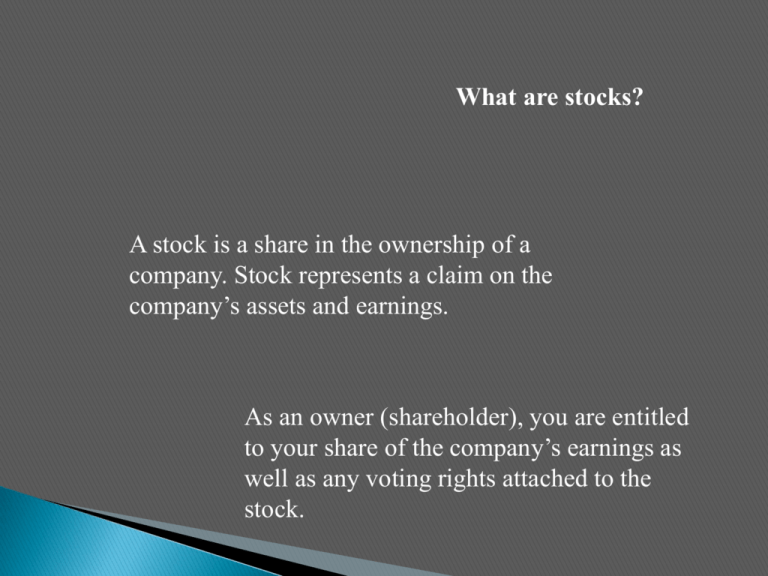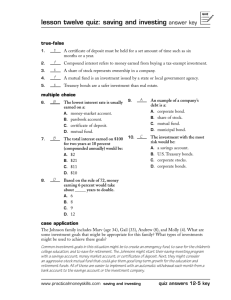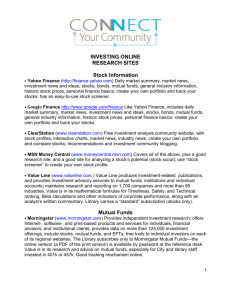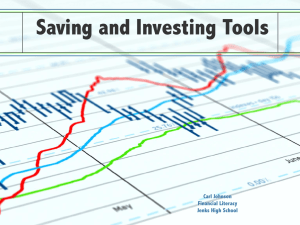
What are stocks?
A stock is a share in the ownership of a
company. Stock represents a claim on the
company’s assets and earnings.
As an owner (shareholder), you are entitled
to your share of the company’s earnings as
well as any voting rights attached to the
stock.
Why do companies issue stock?
At some point every company needs to raise
money. Companies can either borrow it from
somebody or raise it by selling part of the
company.
By issuing stock, the company does not
have to pay back the money or make
interest payments.
What does the shareholder
get out of the deal?
The shareholder gets the hope that the shares
will be worth more in the future.
If the company does well, the stock will
probably increase in value. If the company
does not do well, the shareholder may lose
the money he or she invested.
What’s an IPO?
IPO stands for Initial Public Offering. It’s the
first time the stock is available to the public to
purchase.
The stock exchange itself is a secondary
market. The primary market is the brokers.
Before a company can offer large amounts of stock to
the public, it must register with the SEC (Securities
and Exchange Commission) and prepare a public
offering.
This offering includes a prospectus and a number
of other legal documents. The prospectus is the
accounting and legal equivalent of taking your clothes off.
Everything good and especially bad or risky about the
company, the senior staff, and majority stockowners is
reported in the prospectus for the world to see.
What is a dividend?
A dividend is money that a company pays to its
stockholders from the profits it makes.
Not all companies pay dividends to their
stockholders. The only way shareholders in
these companies make money is to sell the
stock at a higher amount than they bought it
at on the open market.
What is the difference between
common and preferred stocks?
Common stock is the type most people purchase.
It represents ownership of a company and a
claim on part of the profits. Investors get one
vote per stock.
Preferred stocks don’t have the same voting
rights, but investors are usually guaranteed
a fixed dividend. If the company is
liquidated, they are paid off first.
How do stocks trade?
Most stocks are traded on exchanges such as the
New York Stock Exchange or NASDAQ. The
NYSE is a physical location whereas NASDAQ
is a virtual market.
Exchanges are simply places where
buyers and sellers meet and decide on a price
for a stock. Think of it as a flea market where
buyers and sellers come together and agree on
a price for a product.
The New York Stock Exchange
On the NYSE, orders come in through brokerage
firms and flow down to the floor brokers who go
to a specific spot on the floor where the stock
trades.
At this spot, there is a ‘specialist’ whose job is to
match buyers and sellers. Prices are determined by
the auction method. The current price is the
highest price someone will pay and the lowest price
someone is willing to sell for.
The NASDAQ Exchange
NASDAQ is a virtual market called an “over the
counter (OTC) market. It has no central location
or floor brokers. Trading is done through a
computer and telecommunications network of
dealers.
These market makers provide continuous bids and
ask prices within a prescribed percentage spread for
shares for which they are designated to make a
market. They usually maintain an inventory of shares
to meet demands of investors.
What sets the prices on a
stock exchange?
Market forces changes stock prices every day.
Share prices change because of supply and
demand.
If more people want to buy a stock (demand) than
sell it (supply) the price goes up. If more people
want to sell than buy, the price goes down.
What makes people want to buy
one stock and not another?
The price of a stock indicates what investors feel
a company is worth.
The most important factor that affects the value of a
company is its earnings. Earnings are the profit a
company makes. Public companies must report their
earnings on a quarterly basis. If a company has done
well, the stock price will likely rise. If not, it will
drop.
What else might influence
the price of a stock?
Often times current world events have an impact
on the price of stocks.
For example, after 9/11, aviation stocks decreased in
value. This was in anticipation of a drop in traveling
by the consumer and thus a decrease in profits.
This caused a lot of trouble for those companies.
What about all these animals?
The Bull – a bull market is when the economy is
doing well, the GDP is growing and stock prices
are rising. The bull market charges ahead.
The Bear – a bear market is when the economy is bad,
recession is looming and stock prices are falling.
A bear market hibernates and moves slowly.
In Review
•Stock means ownership.
•You can lose all of your investment with stocks.
•The two main types of stocks are common and
preferred.
•Stock markets are places where buyers and sellers come
together.
•Stock prices change according to supply and demand.
•Bulls make money. Bears make money. Chickens sit on
money. Pigs just get slaughtered!
.
Bonds are securities that represent debt owed
by the issuer to the investor, and typically
have specified payments on specific dates.
Types of bonds we will examine include longterm government bonds (T-bonds), municipal
bonds, and corporate bonds.
Copyright © 2009 Pearson Prentice
HallAll rights reserved.
1016
The U.S. Treasury issues notes and bonds to
finance its operations.
The following table summarizes the maturity
differences among the various Treasury
securities.
Copyright © 2009 Pearson Prentice Hall.
All rights reserved.
1018
No default risk since the Treasury can print
money to payoff the debt
Very low interest rates, often considered the
risk-free rate (although inflation risk is still
present)
Copyright © 2009 Pearson Prentice Hall.
All rights reserved.
1019
Issued by local, county, and
state governments
Used to finance public interest projects
Copyright © 2009 Pearson Prentice Hall.
All rights reserved.
1020
Typically have a face value of $1,000,
although some have a face value of $5,000 or
$10,000
Pay interest semi-annually
Copyright © 2009 Pearson Prentice Hall.
All rights reserved.
1021
Cannot be redeemed anytime the issuer
wishes, unless a specific clause states this
(call option).
Degree of risk varies with each bond, even
from the same issuer. Following suite, the
required interest rate varies with level
of risk.
Copyright © 2009 Pearson Prentice Hall.
All rights reserved.
1022
Junk Bonds
◦ Debt that is rated below BBB
◦ Often, trusts and insurance companies are not
permitted to invest in junk debt
◦ Michael Milken developed this market in the mid1980s, although he was convicted of insider trading
Copyright © 2009 Pearson Prentice Hall.
All rights reserved.
1023
The next slide explains in further details the
rating scale for corporate debt. The rating
scale is for Moody’s. Both Standard and
Poor’s and Fitch have similar debt
rating scales.
Copyright © 2009 Pearson Prentice Hall.
All rights reserved.
1024
Some debt issuers purchase financial
guarantees to lower the risk of their debt.
The guarantee provides for timely payment of
interest and principal, and are usually backed
by large insurance companies.
Copyright © 2009 Pearson Prentice Hall.
All rights reserved.
1026
Bonds are the most popular alternative to
stocks for long-term investing.
Even though the bonds of a corporation are
less risky than its equity, investors still have
risk: price risk and interest rate risk.
Copyright © 2009 Pearson Prentice Hall.
All rights reserved.
1027
The next slide shows the amount of bonds
and stock issued from 1983 to 2006.
Note how much larger the market for new
debt is. Even in the late 1990s, which were
boom years for new equity issuances, new
debt issuances still outpaced equity by
over 5:1.
Copyright © 2009 Pearson Prentice Hall.
All rights reserved.
1028
Copyright © 2009 Pearson Prentice Hall.
All rights reserved.
1029
Mutual funds are a type of investment that
takes money from many investors and uses it
to make investments based on a stated
investment objective.
Each shareholder in the mutual fund
participates proportionally (based upon the
number of shares owned) in the gain or loss
of the fund.
Mutual funds offer investors an affordable way to
diversify their investment portfolios.
Mutual funds allow investors the opportunity to
have a financial stake in many different types of
investments.
These investments include: stocks, bonds, money
markets, real estate, commodities, etc…
Individually, an investor may be able to own stock
in a few companies, a few bonds, and have money
in a money market account. Participation in a
mutual fund, however, allows the investor to have
much greater exposure to each of these asset
classes.
Most mutual funds are professionally
managed by an investment expert known as
a portfolio manager.
This individual makes all of the buying and
selling decisions for the fund.
There are thousands of different mutual
funds in the United States.
This provides investors with many options
to help them achieve their investment
objectives.
1.
2.
3.
4.
5.
Mutual Funds can be divided into five basic
categories based upon the funds investment
objective.
These categories are:
Money Market Mutual Funds
Stock Mutual Funds
Index Funds
Bond Mutual Funds
Balanced Mutual Funds
This is the most conservative type of mutual fund.
The goal is to maintain the $1 value of its shares
while providing income.
Invests in high-quality, short-term securities such
as certificates of deposit, U.S. Treasury Bills, and
U.S. Treasury Notes.
MMMF’s are an appropriate place for savings.
These funds have typically offered higher interest
rates than bank savings accounts.
Money market mutual funds are not insured by the
FDIC.
Type of fund that invests in stocks.
These funds are also known as equity
funds.
There are many different types of stock
mutual funds.
Some of the most common include:
Large-cap funds, mid-cap funds, small-cap
funds, income funds, growth funds, value
funds, blend funds, international funds, and
sector funds.
These are mutual funds whose holdings aim to
track the performance of a specific stock market
index.
The most common index fund tracks the S&P 500.
These index funds invest in the exact stocks (and
in the same percentages) as those found in the S&P
500.
Index funds also track bonds, real estate, and other
types of assets.
These funds are lower cost than other types of
funds.
Type of mutual fund that invests in bonds.
There are different types of bond mutual
funds.
Typically, bond mutual funds have the
objective of providing stable income with
minimal risk.
These are also known as hybrid funds.
These mutual funds invest in stocks, bonds,
and money markets.
These are very diversified mutual funds. The
stock portion of the fund provides the
potential for making money, while the bond
and money market portion provide stability









